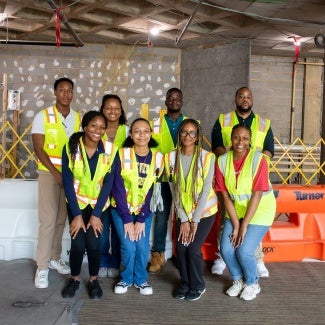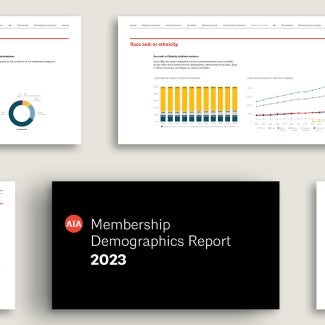Leading the next generation
For three years in a row, AIA members have elected a woman to serve as president. During Women's History Month, we reflect on what this milestone means for the profession and the next generation of women architects.

By Patra Wroten
Nashville-based architecture student Kim Paige Sullivan began her career a decade ago in the music industry. While on tour with clients, she would find herself spending free time roaming new cities to explore and appreciate architecture. When the COVID-19 pandemic took her off the road, Sullivan enrolled in Belmont University’s new architecture school. While preparing for her second act, Sullivan is making plans to assert herself within the communities she will soon serve as an architect.
“I came of age in my twenties, during the #MeToo movement. I was in the music industry, the entertainment world, so I saw a drastic change [for women in the workplace] within a few years of my career as a young adult,” said Sullivan, 30. “In architecture, I don't know if Nashville is like other cities, but I just feel like I’m surrounded by women empowerment.”
In her college cohort, 65% of students are women. Sullivan interned at EOA Architects, a majority women-owned firm, and she joined AIA during the peak of its historic movement toward women leaders: In 2021, Lakisha Ann Woods, CAE, was hired as EVP/CEO, followed by three consecutive years, 2023-2025, of members electing a woman to serve as AIA president. Perhaps that is why when asked where she sees her career in 10 years, Sullivan’s vision isn’t on the type of architecture she wants to practice, but simply the type of architect she wants to be.
“I really hope to be a leader at a firm that has a lot of involvement in Nashville,” said Sullivan.
Changing the image of leadership
“Twenty years ago…if you told me that I would have help usher in this historic moment, I would have likely laughed - not from humor, but from embarrassment that it took so long,” said 2023 AIA President Emily Grandstaff-Rice, FAIA. “But here we are, and now I just smile with pride.”
It took more than a century after AIA was founded in 1857 for members to elect a woman as president. Susan A. Maxman, FAIA, was first, serving in 1993. Grandstaff-Rice was only the sixth woman to serve in the role, and at the time, the youngest person. Current president Kimberly Dowdell, AIA, NOMAC, followed as the first Black woman and millennial. In 2025, Evelyn Lee, FAIA, will take office.
“The interesting thing about making history is it isn’t the reason I got involved in AIA leadership,” said Grandstaff-Rice. "It was more that my voice had agency, and that I saw an opportunity to shape the conversation to be more equitable and inclusive.”
Across all industries, decades of research suggests diverse leadership brings benefits to employee satisfaction, a company’s financial performance , and even stock investments. As AIA boasts a Board and senior leaders more diverse than ever, “it signals to the profession and the marketplace that women are able to come into these positions, lead, and help push progress forward,” said Dowdell. “Now, women, particularly, have multiple role models.”
So far, no women have declared their candidacy to run for president in 2026, but AIA’s presidential three-peat marks a clear shift in culture.
“There's a sense of pride in knowing that you're contributing to a more inclusive and representative leadership, one that reflects the diverse talents and perspectives within our community,” said Lee. “It's exhilarating to be part of something bigger than yourself, to break barriers and pave the way for future generations of architects. But it's also humbling, knowing that you're standing on the shoulders of those who came before you and recognizing the work that still lies ahead.”
Changing the image of design
The work that lies ahead for the next generation will focus, Sullivan says, on making the design process more inclusive.
“In my architectural theory class last semester, part of our discussions revolved around the Architectural Graphic Standards' book, which features design principles tailored for a 6-foot, slender man,” said Sullivan. “This highlights a significant issue in our field; we're not just designing for a single archetype. We should be designing for diversity in all human shapes and sizes."
While Lee, Dowdell, and Grandstaff-Rice have helped change the modern image of what an architect looks like, Sullivan is determined to help change the general image of those for whom architects design.
“I think it's so important for leaders in any industry to mirror the diversity and the richness that their community represents,” said Sullivan. “I've always loved architecture, but I've been learning over the last four years the importance that architects have on the built environment. It’s such an incredible time to be a woman in this field.”




